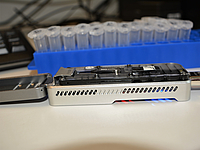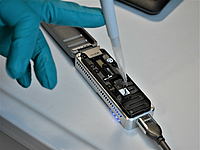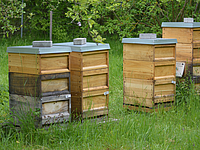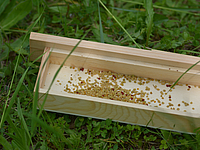Development of an evaluation method for biodiversity and vitality of pollinators in agricultural areas
About 70 % of crops grown worldwide benefit from pollinators. However, bees and other animals are endangered to agricultural stressors. Detailed knowledge of the foraging behaviour in different landscape scenarios is therefore necessary to ensure that pollination by bees can remain to be an important ecosystem service in the future. The implementation of suitable sequencing methods as well as processing of the resulting sequence data is an important step towards establishing sustainable nature conservation. In the longer term, nanopore sequencing is to be used primarily for immediate investigations in the field. This means that samples are taken in the field, prepared and sequenced with the MinION in order to obtain results quickly and therefore be able to act accordingly. Already in 2015, a ground-breaking diagnostic investigation was carried out in the West African Ebola region of Guinea by sequencing the Ebola virus during the outbreak with the MinION. Next to surveillance, quick measures could be taken to care for the patients1.
Our contribution
Biomonitoring based on environmental DNA-analyses is characterized by a completely animal- and environmentally friendly working routine2. This is achieved by using DNA-material that is found in the environment, such as soil samples, river water or sediment. DNA is also found in pollen that adheres to pollinators3. Pollen loads that are formed on the bee’s legs during their collection flights are stored in the nests or hives to supply the brood4. A genetic analysis of the collected pollen DNA allows conclusions to be drawn about the collection behaviour. Depending on the positioning of the bee hives, ecological issues can be addressed.
Through the establishment of DNA-barcoding and genomic studies, more precise and informative statements on biological questions can be made2. Thus, ecologists and agronomists can deduce which foraging strategy pollinators pursue in view of the geographical location of their hives (mass-flowering fields, pastures, fruit tree plantations, etc.). Consequently, this type of biomonitoring does not require disturbing or even destructive observation efforts in the field.
Results so far
 Fragments of the genetic information (DNA) of pollen collected from bumble and honey bees have already been examined using two DNA-sequencing methods in cooperation with Catrin Westphal, Chair of Functional Agroecology at the Georg-August University in Göttingen. In addition to the results of a common polymerase-based sequencing method, we have used novel nanopore sequencing to study pollen DNA5. Using a special region of the pollen genome, the ITS2-region, the visited plants were bioinformatically identified and the pollen content quantified. It was found that bumble bees visited a wider range of plants than honey bees did under the same site conditions. In addition, both bee species are not restricted to mass-flowering crops such as oilseed rape - despite the additional effort involved, other flowering plants are always visited. This can be seen as a further argument for the establishment of field margins and inter-cropping.
Fragments of the genetic information (DNA) of pollen collected from bumble and honey bees have already been examined using two DNA-sequencing methods in cooperation with Catrin Westphal, Chair of Functional Agroecology at the Georg-August University in Göttingen. In addition to the results of a common polymerase-based sequencing method, we have used novel nanopore sequencing to study pollen DNA5. Using a special region of the pollen genome, the ITS2-region, the visited plants were bioinformatically identified and the pollen content quantified. It was found that bumble bees visited a wider range of plants than honey bees did under the same site conditions. In addition, both bee species are not restricted to mass-flowering crops such as oilseed rape - despite the additional effort involved, other flowering plants are always visited. This can be seen as a further argument for the establishment of field margins and inter-cropping.
Through bioinformatic analyses of the sequence data sets, it was recognised that modern nanopore sequencing is equally suitable for the investigation, but has advantages due to its portability and the lower time and cost expenditure.
1 Quick, J.; Loman, N. & Duraffour, S. et al. (2016): Real-time, portable genome sequencing for Ebola surveillance. Nature. 530(7589):228-232. doi:10.1038/nature16996
2 Keller, A.; Grimmer, G. & Sickel, W. et al. (2016) DNA-Metabarcoding-ein neuer Blick auf organismische Diversität. BioSpektrum. 22: 147. DOI: 10.1007/s12268-016-0669-0
3 Taberlet, P.; Bonin, A. & Zinger, L. et al. (2018): Environmental DNA: For Biodiversity Research and Monitoring. Oxford University Press
4 Jarczok, R. (Rdk.) (2018) Arbeiten mit Bienen – Imkern. Garant Verlag GmbH
5 Leidenfrost, R.M.; Bänsch, S.; Prudnikow, L. et al. (2020) Analyzing the Dietary Diary of Bumble Bee. Front Plant Sci 11:1572. DOI: 10.3389/fpls.2020.00287
The Mittweida team consists of Lisa Prudnikow, Robert Leidenfrost and Professor Röbbe Wünschiers. The research project is supported by the Sächsisches Staatsministerium für Wissenschaft, Kultur und Tourismus and the European Social Fund.
Publications
Leidenfrost RM, Bänsch S, Prudnikow L, Brenig B, Westphal C and Wünschiers R (2020) Analyzing the Dietary Diary of Bumble Bee. Front. Plant Sci. 11:287. doi: 10.3389/fpls.2020.00287
Conference and conference contributions
Herkunftsbestimmung von Pollen zur Analyse des Sammelverhaltens von Honigbienen und Hummeln durch Nanoporen- und Polymerase-basierte Sequenzierungsverfahren
Prudnikow, Lisa; Leidenfrost, Robert; Wünschiers, Röbbe
21ste Nachwuchswissenschaftlerkonferenz NWK20, Jena/Germany; Accepted 20.03.2020
Herkunftsbestimmung von Pollen zur Analyse des Sammelverhaltens von Honigbienen und Hummeln.
Lisa Prudnikow, Robert Leidenfrost & Röbbe Wünschiers
20ste Nachwuchswissenschaftlerkonferenz NWK19, Merseburg/Germany; 18-19th of June 2019
Reading Plant ITS2-Sequences with Nanopores and Polymerases: First Insights to Pros and Cons.
R Leidenfrost, S Bänsch, L Prudnikow, C Westphal & R Wünschiers
15th Gatersleben Research Conference on Applied Bioinformatics in Crops
Leibniz Institute of Plant Genetics and Crop Plant Research, Gatersleben/Germany; 18-22nd of March 2019


